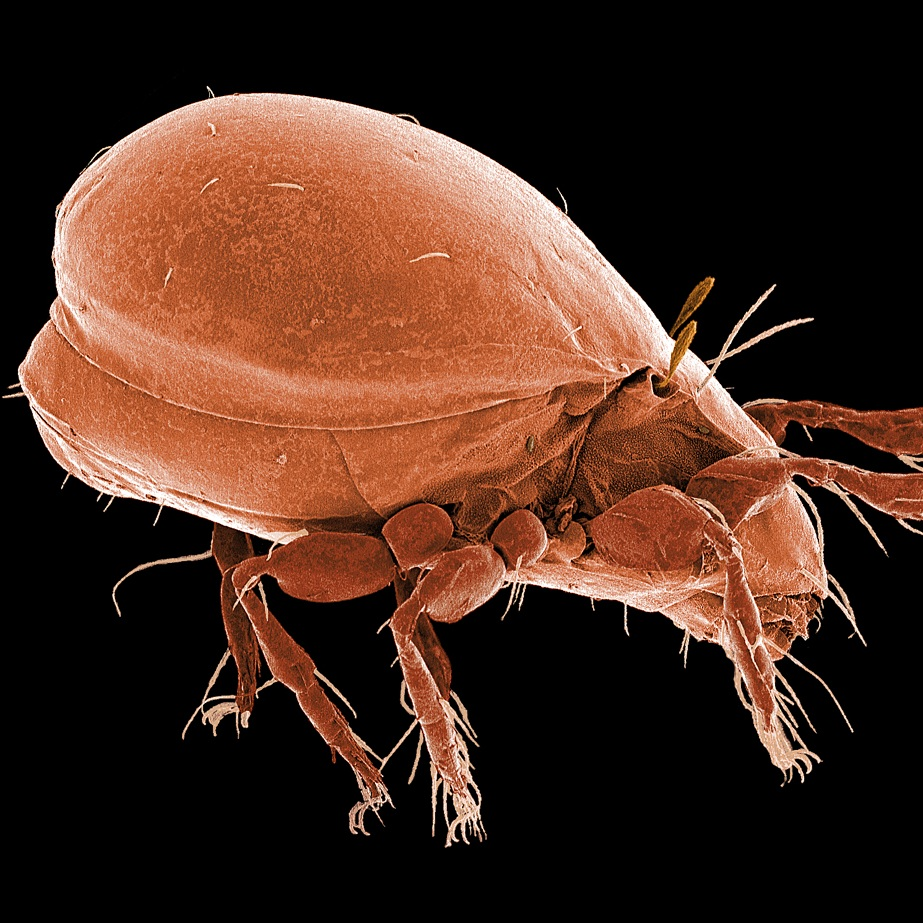If I asked you to name the strongest animal on Earth, you’d probably think of something huge and powerful like an elephant, lion, or even a bear, right? But what if I told you there’s an animal smaller than a grain of sand that can put all these mighty creatures to shame? Sounds unbelievable, doesn’t it? Well, believe it or not, it’s absolutely true! Meet the oribatid mite—a microscopic powerhouse that lifts loads that would crush even the strongest humans.
Let’s dive deeper into this tiny yet incredibly strong creature and discover exactly how it manages such amazing feats.
Meet the World’s Strongest Animal: The Oribatid Mite

Oribatid mites aren’t exactly celebrities in the animal kingdom. You probably haven’t even heard of them before today. These tiny creatures weigh less than 25 micrograms—that’s smaller and lighter than the grains of sand you casually brush off your hands at the beach. Yet, despite their minuscule size, oribatid mites pack a muscular punch that’s simply extraordinary.
Scientists have observed these microscopic creatures lifting objects up to 1,180 times their own body weight. To put this into perspective, imagine if you could lift a massive cargo ship or about 82 tons. Sounds impossible, doesn’t it? But that’s exactly the kind of strength oribatid mites exhibit daily. It’s an awe-inspiring example of nature’s hidden wonders.
Why Are Oribatid Mites So Amazingly Strong?
You might wonder, how is it even possible for something so tiny to achieve strength on this superhuman level? Well, it all boils down to some fascinating biology and physics working hand-in-hand.
Video : Meet the Tiny Mite That’s Stronger Than Superman
Incredible Muscle-to-Body Ratio
One reason oribatid mites are freakishly strong is due to their unique muscle-to-body-weight ratio. Because they don’t have heavy internal skeletons like humans or elephants, their bodies can pack in a higher percentage of pure muscle. Think of it this way: imagine a weightlifter who’s all muscle and no extra fat—that’s essentially what an oribatid mite is like, just on an incredibly microscopic scale.
The Advantage of Their Small Size
Additionally, their tiny size contributes massively to their strength. Oribatid mites have a large surface-area-to-volume ratio. This ratio allows their muscles to operate more efficiently with significantly less energy waste. Simply put, their small muscles expend far less energy moving their lightweight bodies around. The result? Extra strength to spare for lifting and carrying heavier objects.
No Internal Skeleton Means Less Weight, More Strength
Here’s another fascinating fact: oribatid mites, like most insects and arthropods, possess an external skeleton (exoskeleton) rather than internal bones. This exoskeleton provides strength and protection without the heaviness associated with internal bones. Less internal weight means more muscle space, translating directly into incredible lifting power.
Habitat and Life of the Mighty Oribatid Mite
Now, you might be curious—where exactly do these tiny champions live? Surprisingly, oribatid mites are incredibly common. In fact, they dominate many forest floors and soil ecosystems worldwide. Hidden among decaying leaves, organic matter, and damp soil, oribatid mites quietly play essential roles in maintaining ecological balance.

Beneficial Contributions to Ecosystems
Oribatids aren’t just impressive weightlifters—they’re environmental heroes too. These mites actively improve soil quality by aiding seed dispersal, breaking down organic matter, and controlling populations of harmful parasites and insect pathogens. By keeping soils healthy, they indirectly support plant growth, animal health, and even human agriculture.
Slow Growth but Long Evolutionary History
Despite their impressive strength, oribatid mites live life at a leisurely pace. They have low metabolic rates, grow slowly, and take anywhere from a few months to two full years to mature from egg to adulthood. Interestingly, their life cycle is remarkably complex, going through six distinct developmental stages—pre-larval, larval, three pupal stages, and finally adulthood.
And here’s something even more incredible: these tiny mites have likely roamed Earth’s soils for 300 to 400 million years. That means oribatids have outlasted dinosaurs, ice ages, and countless other species, quietly thriving and evolving beneath our feet.
What Can We Learn from Oribatid Mites?
Beyond their awe-inspiring strength and resilience, oribatid mites offer us powerful lessons about adaptation and efficiency. They demonstrate vividly that size doesn’t always correlate with power or importance. Their success in nature results from perfect adaptations to their environment, optimized anatomy, and the efficiency of their muscles.
Video : Oribatid mite (Acari: Cryptostigmata) from soil at Ibaraki Prefecture, Japan
Think about it—what if humans could mimic even a fraction of this efficiency? We’re always looking to build stronger yet lighter materials, more powerful yet smaller machinery. The oribatid mite, tiny as it is, might just provide inspiration for future advancements in technology, engineering, and biomechanics.
Conclusion: Celebrating the Tiny Giant of the Animal World
So, the next time you think about powerful creatures, don’t limit yourself to elephants, gorillas, or lions. Remember the astonishing oribatid mite, a tiny animal no bigger than a grain of sand, capable of lifting unimaginable weight relative to its body size.
These mites remind us vividly that power isn’t always about size or strength that you can easily see. Sometimes, real strength is hidden in the smallest creatures on Earth, patiently living beneath our notice. Isn’t that fascinating? Nature truly never stops surprising us.
From their exceptional strength to their important ecological roles, oribatid mites are remarkable creatures deserving more recognition. Let’s celebrate these tiny yet powerful champions that teach us valuable lessons about strength, efficiency, and adaptation.
Next time you stroll through a forest, take a moment to consider the microscopic miracles happening beneath your feet—you just might be walking above the strongest animals on the planet!
What to Know about the Stunning Northern Lights for Friday Night: Details

The breathtaking aurora borealis may be visible this Friday night across several US states. This is thanks to a recent space phenomenon.
A geomagnetic storm pushed the northern lights further south than usual this week. As a result, the National Oceanic and Atmospheric Administration’s Space Weather Prediction Center (NWSSWPC) calculates another chance to see them at the right location on October 11, 2024, after many witnessed the event the previous day.
The NWSSWPC has been tracking the aurora’s activity and predicts a KP index of five for Friday night. This index, ranging from 0 to 9, indicates the intensity of the aurora.
A KP of 5 suggests a brighter and more active aurora, potentially visible further south than usual. The aurora typically appears as a green oval centered on Earth’s magnetic pole, but it can turn red during periods of heightened activity.
While often seen just after sunset or before sunrise, the aurora is not visible in daylight. Interestingly, it doesn’t have to be directly overhead to be seen; under ideal conditions, it can be observed from as far as 1,000 km (approximately 621 miles) away.
This celestial display isn’t just a visual wonder; it also serves as an indicator of geomagnetic storm conditions. These events can impact various technologies, including radio communication and GPS navigation
The NWSSWPC emphasizes the aurora borealis as an exceptional opportunity for many to personally experience the wonders of space weather. It is a captivating nighttime display that entices people to journey to Arctic regions simply to witness its beauty.
To see this event, the NWSSWPC suggests finding a location with minimal light pollution and an unobstructed view to the north. A higher vantage point, like a hill, can further enhance your viewing experience. Additionally, the optimal time to watch is usually within an hour or two of midnight, between 10 PM and 2 AM local time.
So, which states are most likely to catch this dazzling display? According to the view line calculated by the NWSSWPC, Alaska and northern parts of Washington have a higher chance of seeing it. Idaho, Montana, North Dakota, Minnesota, and Wisconsin are also in this range.
Other states, including Montana, South Dakota, Iowa, Michigan, New York, New Hampshire, Vermont, and Maine, also have a possibility, though the likelihood is lower
Areas in the rest of the world may also see them. For example, the Meteorological Office predicts that cloudy skies will limit vision for most of the UK, except for Scotland.
This week’s stunning aurora borealis displays weren’t a surprise. The NWSSWPC issued a G4 storm watch on October 9th, 2024, following a coronal mass ejection from the Sun on October 8th.
This powerful solar event had the potential to cause significant disruptions to crucial infrastructure. “There is potential to reach G4 (Severe) upon arrival of this CME and throughout its passage,” the NWSSWPC warned. Eventually, the storm got stronger than initial predictions.
Therefore, this Friday night aurora borealis promises a captivating spectacle for those lucky enough to witness it. However, remember, these predictions can change depending on local weather conditions. Also, the unpredictable nature of this space phenomenon also factors into any chance of viewing.



Leave a Reply